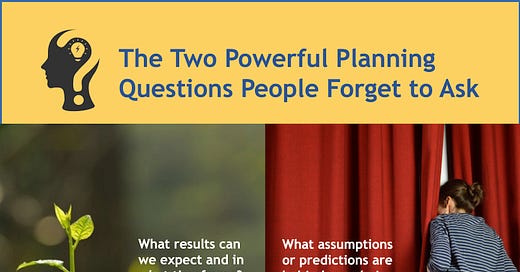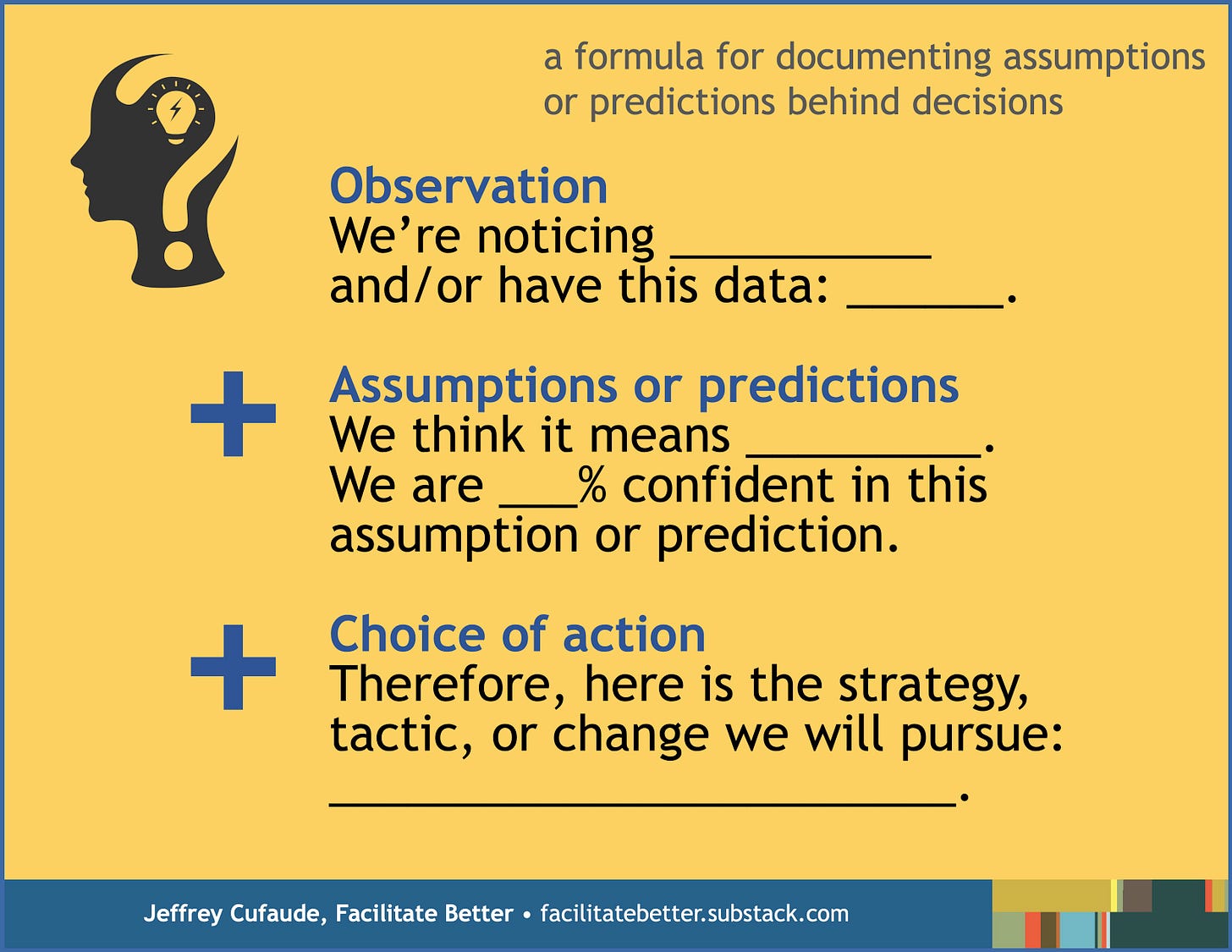The Two Powerful Planning Questions People Forget to Ask (Facilitation Friday #24)
Effective facilitation helps groups surface, explore, and document the critical assumptions influencing their choices and the envisioned timeframe for any results.
How stocked is your supply of failsafe planning questions? I’m talking about the ones essential to ask in almost any change management, strategy development, or operational planning session.
Whether your cupboard is quite bare or you only have room for a few more, here are two I strongly recommend. Both help calibrate expectations and provide context for those who weren’t involved in the conversations, but still need to understand and implement the output. They also help those involved with later recall and review.
Nonprofits, professional associations, and other volunteer-led organizations particularly benefit from answering these two questions given the turnover in their leadership ranks. Having this information readily available can help decision-makers from ending or overly modifying an effort too soon.
1. What results can we expect and in what timeframe?
People benefit from knowing the anticipated time horizons and metrics for progress, particularly for longer-term changes. If you’ve ever planted perennials you may remember this simple mantra to guide the results one can expect: sleep, creep, leap. In short, the best results likely won’t happen until at least year three, so stay the course when things look a bit disappointing.
https://www.americanmeadows.com/the-tool-shed/sleep-creep-leap-how-perennial-plants-grow
It is easy to be unrealistic or overly ambitious about the results we expect and when they will occur. When they fail to materialize, some are so demoralized that they give up. Or we may experience some initial progress quite quickly, but then plateau well short of our goal with any additional positive results coming much more incrementally.
Identifying and communicating realistic benchmarks for different timeframes helps reduce unnecessary disappointment or inappropriate reactions.
2. What assumptions or predictions are behind our choices and what is our degree of certainty in them?
When a tropical storm initially forms in international waters off the US coast, forecasters tend to be uncertain about it reaching hurricane status, when it might make landfall in the US, the communities most in danger, or the hurricane category expected. Over time, those assumptions and predictions get more specific and usually are offered with an increasing degree of confidence. Sharing this information transparently allows elected officials, businesses, and individuals to make more informed choices.
Strategy, operational planning, and change management efforts also are based on a set of assumptions about current and future conditions and presumably, some degree of confidence in them. It is less common that this information is overtly surfaced, documented, and shared with others.
This can become problematic when the chosen strategy or changes are communicated to individuals who were not involved in the conversations that produced them. Lacking the conversational context, they may find the output confusing, undesirable, or inconsistent with what they think is the right thing to do.
In some respects, this is similar to algebra. Remember how you could get the wrong answer, but still get partial credit for your work? Individuals who think a committee, board, or individual leader has come up with the “wrong answer” might still afford partial credit for the work if the assumptions and confidence intervals behind the choices were documented. Here’s a simple format I use to do so.
Bottom Line
Effective facilitation helps groups surface, explore, and document the critical assumptions influencing their choices and the envisioned timeframe for any results. Doing so provides the intended audiences for this information with a peek behind the curtain or a backstage pass to the deliberations. This additional information can help provide clarity for output that otherwise might be resisted or questioned.
Getting in Action
Identify a future session where you can experiment with these two questions and how you would use them with participants.
Generate a short list of other timeless planning or change management questions you think should be used more regularly during those conversations.
Look at an existing strategic plan and determine how you might add a “sneak peek” into the assumptions that shaped it so that others might better understand and support the plan’s strategies, goals, and objectives.
© Facilitate Better and Jeffrey Cufaude. All rights reserved.
To affordably license this content for reprint on your site or in electronic or print communications or to contact me regarding customized facilitation skills workshops or consultations, complete this form.






